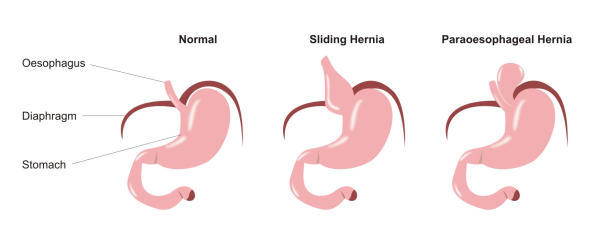Hiatus Hernia
What is a hiatus hernia?
Normally, the stomach sits completely below the diaphragm. The oesophagus (gullet) passes through a hole in the diaphragm (called hiatus) to join the stomach just below the diaphragm.
A hiatus hernia occurs when the top part of the stomach, where it joins the oesophagus(gullet), moves up into the chest through the hole in the diaphragm. It is a very common condition occurring in about one in ten individuals.
Types of Hiatus Hernia?
- Sliding type: This is the most common type and it occurs when the junction of the oesophagus and the stomach slides up into the chest.
- Rolling (paraesophageal) type: In this type, the junction between the stomach and oesophagus remains in the normal position in the abdomen but another part of the stomach moves up in the chest through the hole in the diaphragm. This type is more prone to complications.
- Mixed type: This is a mixture between the first two types
- Complex type: This occurs when the hernia is so big that other organs beside the stomach (e.g. colon, spleen or liver) move into the chest.

What are the causes of hiatus hernia?
The exact cause of hiatus hernia is not known. A variety of factors can predispose to hiatus hernia.
- Obesity
- Heavy lifting or straining
- Smoking
- Certain medications e.g. steroids
- Connective tissue disorders
- Kyphosis (hunchback)
What are the symptoms of hiatus hernia?
- No symptoms Most people with hiatus hernia have no symptoms. The hernia is often picked up by chance on a Barium xray, gastroscopy, chest xray or CT scan.
- Symptoms related to acid reflux (Gastro-Oesophageal Reflux Disease or GORD. Some people will have heart burn or regurgitation. This due to the back flow of the acidic fluid of the stomach into the oesophagus. These occur more often after lying flat or bending down.
- Other symptoms like:
- gurgling noise in the chest
- severe pain in the chest that resembles heat attack
- hiccups and belching
- shortness of breath
What are the complications of Hiatus Hernia?
Majority of people will not have any complications from their small hiatus hernias. People with acid reflux (GORD) may develop complications due to acid damage. These include narrowing of the oesophagus (stricture), recurrent chest infection, hoarse voice, acid damage othe teeth, Barrett's oesophagus and rarely, oesophageal cancer.
Occasionally pressure causes by the edge of the diaphragm rubbing against the wall of the stomach can cause ulcers in the stomach leading to bleeding from the ulcers.
Patients with large hiatus hernia can develop serious complications. The stomach can twist (called volvulus) inside the chest causing obstruction. This can lead to strangulation of the stomach when the blood supply to the stomach gets blocked. If not fixed urgently the stomach quickly dies.
What is the treatment of Hiatus Hernia?
Non symptomatic hernias can be left without treatment. Patients with mild to moderate GORD are treated with life style changes and medical therapy. This is effective most of the time. Click here to read more about non-operative treatment of GORD.
Some patients are better served with an elective operation.
When to consider surgery for hiatus hernia?
- GORD not responding to or not tolerating medical treatment.
- GORD with "volume reflux". Patient with large volume reflux who get a mouthful of gastric juice when they bend over or when they lie flat should consider surgery.
- GORD with complications
- Hiatus hernia with pressure symptoms. This is caused by the pressure of the stomach in the chest on the lungs and the heart leading to pressure sensation, chest pain and shortness of breath. It is important to repair these hernias before they cause serious complications e.g. obstruction or strangulation.
How do we repair a hiatus hernia?
This is a specialized operation that is performed keyhole (by laparoscopy) most of the time. The hernia sac and stomach are reduced into the abdomen. Working through the hiatus opening, the oesophgus (gullet) is freed inside the chest to allow the stomach and its junction with the oesophagus to sit in the abdomen. The hole in the diaphragm (hiatus) is repaired with stitches and sometimes mesh. Lastly a fundoplication is performed where the top part of the stomach is wrapped around the lower end of the oesophagus to recreate the one way valve at the lower end of the oesphagus.
Occasionally the surgery need to be done using the open method especially if there were lots of adhesions from previous surgery or if the stomach is friable because of acute obstruction.
